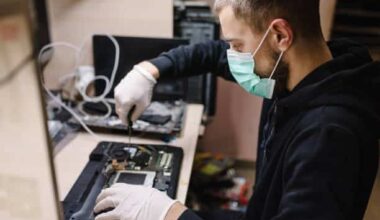Table of Contents
- What is Ultrasonography
- Who Is an Ultrasonographer
- Ultrasonographer Job Description
- Duties of an Ultrasonographer
- Where and How does an Ultrasonographer work
- Requirements To Becoming an Ultrasonographer
- Schools Granting Certification in Ultrasonography in 2021
- #1. Ferris State University (BIG RAPIDS, MI)
- #2. Parker University (DALLAS, TX)
- #3. Pennsylvania College of Health Sciences (LANCASTER, PA)
- #4. The University of Findlay (FINDLAY, OH)
- #5. Nebraska Methodist College of Nursing and Allied Health (OMAHA, NE)
- #6. University of Alaska Anchorage (ANCHORAGE, AK)
- #7. Mount Aloysius College (CRESSON, PA)
- #8. Mercy College of Health Sciences (DES MOINES, IA)
- #9. Southeast Technical Institute (SIOUX FALLS, SA)
- How Much Is The Salary of an Ultrasonographer?
- Conclusion
- FAQs
- Publisher Recommendation
In the field of research and development, many questions linger as to attaining a career path in ultrasonography. Becoming an ultrasonographer and many more unanswered questions as regards the subject matter; “ How to become an Ultrasonographer”, has gotten quite its traffic on the google search engine.
This article has been assembled by our team of Research experts to offer knowledge on all that entails to an Ultrasonographer and its whys and hows of operation in the area of Scientific advancement as well as the future expectations at large.
In other words, let us dive deeper into What is Ultrasonography as one should understand what it is before holding unto it as a career path.
What is Ultrasonography
Ultrasonography is also known as Medical ultrasound which includes diagnostic imaging techniques, as well as therapeutic applications of ultrasound. In diagnosis, It is used to create an image of internal body structures such as tendons, Muscles, Joints, Blood vessels and Internal organs.
Its aim is usually to find a source of disease or to exclude pathology. Many other principles and fields apply under ultrasonography e.g The practice of examining a pregnant woman which is known as PATHOLOGY.
Furthermore, by the National Cancer Institute; Ultrasonography is the procedure that uses high energy sound waves to look at tissues and organs inside the body. The sound waves make echoes that form pictures of the tissues and organs on a computer screen (sonogram). Ultrasonography may be used to help diagnose diseases, such as cancer.
Who Is an Ultrasonographer
An ultrasonographer is medical professionals who use equipment that produce sound waves of high frequency to make internal pictures of a patient’s body. They perform non-invasive medical procedures that detect and diagnose abnormalities and medical conditions.
These procedures can be done using 2-D or 3-D, or Doppler ultrasound equipment. According to the US Bureau of Labour Statistics ( BLS).
Ultrasonographer Job Description
A question about a broad scale understanding of how an ultrasonographer goes about his affairs has been around for a while. So let’s look into a clear description of how an ultrasonographer works in his field and various aspects in the field as well.
The Ultrasonographers use this ultrasound to observe body structures without the use of radiations. It is faster than using other radiographic techniques. An ultrasonographer may choose from specializations such as the following, which focus on the listed body parts :
- Nuerosonography : This area involvs the nervous system, along with the Brain.
- Echocardiography : Cardiovasscular system or the Heart.
- Ophthalmology : Abnoormalities in the eye OR surrounding blood vessels.
- Obstetrics and gynecological ultrasound : Female reproductive Organs along with monitoring fetal development during pregnancy.
Duties of an Ultrasonographer
So to bring into simple consideration the duties I.e the major work of an ultrasonographer.
To perform ultrasounds, ultrasonographers generally work in darkened rooms. They stand on their feet most of the time and must be capable of turning or lifting patients. They may also find themselves performing the list of tasks listed below:
- Working closely with patients to explain procedures.
- Assisting physicians with biopsies.
- Maintaining patient records.
- Choosing and maintaining ultrasound equipments.
- Working with other professionals, such as Radiologists.
- Processing diagnostic information, Including photos and videos.
- Preparing patient histories
Where and How does an Ultrasonographer work
Ultrasound technologists often work in physically and emotionally damaging environments, they tend to complete most of their works at diagnostic imaging machines found in dimly lit rooms. Although they may also work at patients’ bedsides.
In addition, they spend much of their day on their feet and are constantly walking. They may also have to lift or move the heavy imaging equipment themselves, as well as move disabled patients or adjust their positions on a bed.
While diagnostic medical sonographers may get to share the happy news with patients such as information about fetal ultrasounds, they may also have to deal with notifying patients about unfortunate news regarding certain health ailments.
An Ultrasound Technician or an ultrasonographer can work in a variety of settings, most of which depends upon their specialization. Popular ultrasound technician specializations may include echocardiography, gastroenterology, obstetrics (OB/GYN), Neurology and ophthalmology.
According to the US Bureau of Labour Statistics (BLS), more than 50% of ultrasound technicians work in general medical and surgical hospitals. Other popular places of employment include medical and diagnostic laboratories, Physicians offices, Outpatient care centres and educational facilities.
Where you work as a diagnostic medical sonographer may also affect your expected salary range.
There is a standard work schedule that occurs among ultrasonographers. Most ultrasound technicians work a regular 40 hours workweek. Although many medical facilities are open 24/7, the Ultrasound technician may be required to work overnight, weekends and evenings.
Sonographers may also be required to fulfill on-call emergency shifts at hospitals and other medical facilities. For those who work in mobile testing medical laboratories, travel may be required to reach communities that do not have access to ultrasound technology equipment.
READ ALSO: Ultrasound Technologist | What They Do, Salary, Required Skills, And More.
Requirements To Becoming an Ultrasonographer
Based on the US Bureau of statistics, The criteria listed below are essential for the acquisition of certification and eligibility to work as an ultrasonographer. This important necessity is what makes ultrasound technicians readily liable to function in any institute or organization where ultrasound techniques are needed;
- He/She must have attained an ASSOCIATE’S DEGREE.
- The Associates degree should entail DIAGNOSTIC MEDICAL SONOGRAPHY.
- Must attain a certificate preferred by most employers, some states also require LICENSING, which typically requires certification first.
- One must have a field experience of about 1-3 years.
- Good communication skills and ability to follow directions.
Moreover, not letting aside an important factor I.e The several institutions/ Colleges that grant certification in this field. The below section entails the several schools that grant certification in Ultrasonography.
Schools Granting Certification in Ultrasonography in 2021
Ultrasound technicians benefit from above-average earning potential and strong employment projections. Graduate with an associated degree from an ultrasound technician program can qualify for careers in diagnostic medical sonography.
Programs for ultrasound technicians include training in sectional anatomy, ultrasound technology and diagnostic imaging. Students build foundational knowledge which they apply during labs, Internships and practicums. By incorporating experiential learning, 2-years Ultrasound technician programs prepare graduates for the work office.
#1. Ferris State University (BIG RAPIDS, MI)
The ultrasound technician program at Parker in Dallas, Texas, leads to an associate of applied science (AAS) degree. The 75-credit associate degree in diagnostic sonography accepts only 15 students per year to ensure personalized attention.
#2. Parker University (DALLAS, TX)
The ultrasound technician program at Parker in Dallas, Texas, leads to an associate of applied science (AAS) degree. The 75-credit associate degree in diagnostic sonography accepts only 15 students per year to ensure personalized attention.
#3. Pennsylvania College of Health Sciences (LANCASTER, PA)
Established in 1893 as a training school for nurses, PA College now offers more than two dozen degrees in the health sciences field, including an ultrasound technician program.
The associate of applied science in diagnostic medical sonography comprises 66 credits. Most students graduate after two years of full-time enrollment (including summer terms).
#4. The University of Findlay (FINDLAY, OH)
UF offers an ultrasound technician program that leads to an associate of arts degree in diagnostic medical sonography. Applicants need a high school diploma or equivalent with a minimum 2.5 GPA. They must also submit ACT or SAT scores and satisfy prerequisite courses.
#5. Nebraska Methodist College of Nursing and Allied Health (OMAHA, NE)
NMC’s ultrasound technician program requires at least 76 credits for completion. The program leads to an associate of science in multispecialty sonography. Classes cover topics like pathophysiology and pharmacology, applied sectional anatomy, sonographic physics, and high-resolution structures.
#6. University of Alaska Anchorage (ANCHORAGE, AK)
UAA offers an ultrasound technician program that leads to an associate of applied science in diagnostic medical sonography. The program welcomes applications from certified and licensed practitioners with recent experience in direct patient care.
Graduates can sit for various credentialing examinations administered by the American Registry for Diagnostic Medical Sonography.
READ ALSO: How to Become a Dermatologist in California, 2021.
#7. Mount Aloysius College (CRESSON, PA)
The program features 26 general education credits, 47 major credits, and 17 credits of other required coursework. Classes in the major cover topics such as superficial structures and vascular ultrasonography, physics and instrumentation, imaging principles, and cross-sectional anatomy.
#8. Mercy College of Health Sciences (DES MOINES, IA)
The ultrasound technology program at MCHS in Des Moines, Iowa, comprises 76 credits and leads to an associate of science in diagnostic medical sonography (DMS).
Full-time students typically earn the degree in five semesters. Applicants must show satisfactory completion of college-level work in classes such as human anatomy, college algebra, and medical terminology. The program requires a minimum 2.5 GPA.
#9. Southeast Technical Institute (SIOUX FALLS, SA)
Southeast Tech offers an ultrasound technician program consisting of 80 credits and leading to an associate of applied science degree in diagnostic medical sonography (DMS). The program requires the submission of SAT or ACT scores. Applicants must also meet at least one of the following criteria:
- A minimum 3.0 high school GPA
- GED score of 550
- Ainimum 2.5 college GPA (based on a minimum of 16 credits)
- Or satisfactory completion of coursework in math, and science (at least a grade of B).
How Much Is The Salary of an Ultrasonographer?
Ultrasonographer salaries rank among some of the highest of all medical technician fields. The mean annual salary of an Ultrasonographer makes is $77,790 per year, according to the most recent bureau of labor statistics (BLS), May 2020 salary survey.
Those at the high end of the spectrum earned $105,340 whereas those towards the bottom earned up to $53,790. Salary and employment figures are based on a national average and may vary by location.
There are expanded firms with several Annual earning ranges as well for sonographers which are:
- GENERAL MEDICAL AND SURGICAL HOSPITALS – $67,540
- OFFICES OF PHYSICIANS – $66,970
- MEDICAL AND DIAGONISTICS LABORATORIES – $65,330
- OUTPATIENT CARE CENTRES – $73,640
- COLLEGES, UNIVERSITIES & PROFESSIONAL SCHOOLS – $70,630.
Conclusion
In these ways, one should be enlightened on the matter “How to become an Ultrasonographer”. All these were created to expand Clarity on the matter at hand and to pave a path of awareness to those earnestly seeking to carry on along this path.
If there’s any question unanswered be free to leave a question below. If satisfied, be sure to leave a comment and share.
FAQs
Who Is an Ultrasonographer
An ultrasonographer is medical professionals who use equipment that produce sound waves of high frequency to make internal pictures of a patient’s body. They perform non-invasive medical procedures that detect and diagnose abnormalities and medical conditions
How long does it take to become an Ultrasonographer?
It takes 4 years to earn a bachelor’s degree as a sonographer.
How do i become an Ultrasonographer?
The criteria s listed below are essential for the acquisition of certification and eligibility to work as an ultrasonographer;
*He/She must have attained an ASSOCIATE’S DEGREE
* The Associates degree should entail DIAGNOSTIC MEDICAL SONOGRAPHY.
* Must attain a certificate preferred by most employers, some states also require LICENSING, which typically requires certification first.
* One must have Field experience of about 1-3 years.
* Good communication skills and ability to follow directions.
What is the role of an Ultrasonographer?
The duties of Ultrasonographers includes:
* Working closely with patients to explain procedures.
* Assisting physicians with biopsies.
* Maintaining patient records.
* Choosing and maintaining ultrasound equipments.
* Working with other professionals, such as Radiologists.
* Processing diagnostic information, including photos and videos.
* Preparing patient histories
How much is the salary of an ultrasonographer?
Ultrasonographer salaries rank among some of the highest of all medical technician fields. The mean annual salary of an Ultrasonographer makes is $77,790 per year, according to the most recent bureau of labour statistics (BLS), May 2020 salary survey.
Those at the high end of the spectrum earned $105,340 whereas those towards the bottom earned up to $53,790.
Publisher Recommendation
- Surgical Asepsis | Definition, Technique & Example
- How To Become A Mental Health Clinician | What They Do, Requirements, Training, Certificates & Salary.
- How Much Do Substitute Teachers Make In California?
- Ultrasound Technologist | What They Do, Salary, Required Skills, And More.
- Interior Design Degree | A Right Program For You To Study In Germany.
- EKG Technician | How to Become One, Job Description, Salary, Skills & More.
- Environmental Technician | How To Become One, Job Description, Salary, Skills & More.
- Human Resources Assistant | What They Do, Salary, Required Skills and More.
- IT Project Manager | How To Become One, Job Description And What You Will Need To Get Started.
- How Long Does It Take To Get A GED?





